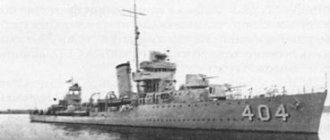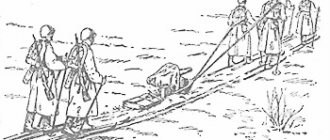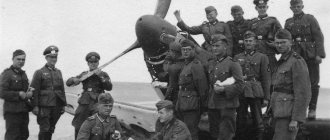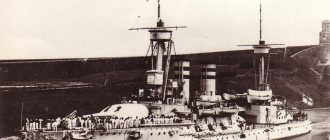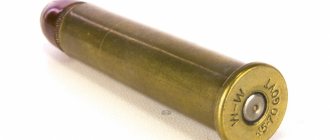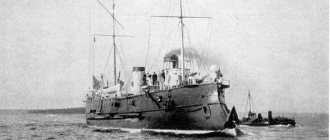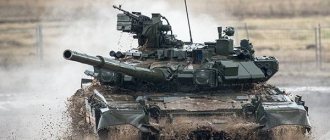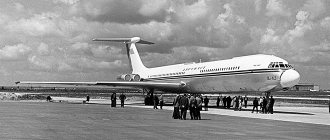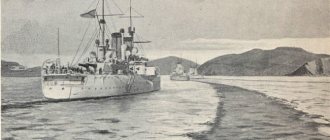Feat of "Varyag"
Vsevolod Fedorovich Rudnev - from the hereditary nobles of the Tula province. Since 1616, the Rudnev family owned an estate in Venevsky district (now Novomoskovsky district). The future legendary commander of the Varyag was born into a family whose many generations served in the Russian fleet.
Admiral's father Fyodor Nikolaevich Rudnev , a hero of the Russian-Turkish War of 1828-1829, retired with the rank of captain 1st rank. After leaving service, he lived on his estate in the Venevsky district, where he raised his son. Vsevolod studied at the St. Petersburg Naval School at the expense of the state - in honor of his father’s military merits.
Captain 1st Rank Rudnev took command of the Varyag on March 1, 1903. By this time, he had already had 30 years of service in the navy, nine overseas and three circumnavigations.
On January 26, 1904, a Japanese squadron of 6 cruisers and 8 destroyers blocked the exit from the bay in the port of Chemulpo, where Russian ships were located - the cruiser Varyag, the seaworthy gunboat Koreets and the steamer Sungari. In the morning, Rudnev received an ultimatum from Japanese Rear Admiral Uriu demanding that he leave Chemulpo before noon.
Japanese troops land at Chempulpo
Otherwise, the Japanese threatened to open fire. Rudnev informed the officers and sailors about the ultimatum and the decision to break out of the bay together with the “Korean”.
“Varyag” and “Korean” go to battle
- Of course, we will engage in battle with the squadron, no matter how strong it is. We will not give up the cruiser and ourselves and will fight to the last opportunity and to the last drop of blood! - he said.
Battle scheme
At the exit from the bay, the Japanese again offered to surrender, but the demand remained unanswered. And then the first shot rang out from the cruiser Asama, after which a battle began. Rudnev was shell-shocked, receiving a head wound, but did not leave the captain's bridge. Among the heroic sailors of the Varyag were our fellow countrymen A. I. Kuznetsov, P. E. Polikov, T. P. Chibisov, the commander’s namesake, the ship’s priest
M. I. Rudnev. The Varyag team inflicted serious damage on 3 Japanese cruisers and sank the destroyer. Of the 570 crew members of the Varyag, 31 were killed and 91 were seriously injured. The guns were smashed and the ship was heavily tilted. And then Rudnev gave the order to remove the crews from the ships, sink the cruiser, and blow up the gunboat.
"Varyag", abandoned by the team
The last secret of the cruiser "Varyag": the sailors were afraid of the tribunal
– Over the past decades, we have been regularly “treated” to sensational “revelations” concerning some “standard” events of the Civil and Great Patriotic Wars... Could “Varyag” really find itself in a similar situation?
– In fact, after a thorough study of the biography of this ship, several very important questions still remain open. And besides, there are well-established misconceptions that create additional confusion and provoke some “researchers” to incorrect conclusions.
One of these misconceptions is associated, for example, with the assertion that the Varyag could break into the open sea past the Japanese squadron and easily escape the enemy ships pursuing it. They say that the commander of the Russian cruiser made a clear mistake by not attempting such a dashing breakthrough, but instead got involved in a protracted artillery battle with an enemy many times superior to him. “After all, the Varyag was then considered one of the fastest cruisers in the world! Not a single Japanese from Uriu's squadron could have kept up with him! - say such “experts”. “And commander Rudnev decided to save, along with his newest ship, the old gunboat “Koreets”, which was also in the port of Chemulpo. Therefore, “Varyag” had to adapt to its slow-moving comrade during the breakthrough, and as a result, this circumstance doomed both Russian ships to failure and death.”
However, surviving documents show that the Varyag was in fact by no means “one of the fastest.” Its record speed of over 23 knots existed only on paper. But in reality, by the time of the battle this ship could develop much less. A few months before the start of the war with Japan, specialist engineers of the Pacific Squadron made a disappointing verdict: the Varyag is only capable of accelerating to 20 knots for a short time, and in normal mode its power plant can be operated at speeds no higher than 14-16 knots.
This sad picture is associated with the unsatisfactory condition of the cruiser’s boilers and steam engines. This was an obvious defect committed by an American company that was building the ship for Russia. Well, the Russian specialists, who accepted the new cruiser from the Shtatovites, for some reason overlooked such a “disease.” The true reasons for such “blindness” of the members of the acceptance committee sent to Philadelphia by the Navy Department remain unknown. But the fact is obvious: “Varyag” was only able to show the record speed indicated in its “passport” during sea trials - it accelerated even over 24 knots during one of the test passages of a measured mile, but only after that, in real operation conditions, its power plant immediately under increased loads started to crumble. So, in the battle at Chemulpo, the “Varyag” was inferior in speed to almost all the Japanese cruisers opposing it and therefore, in principle, could not make a “dashing” breakthrough even after parting with the “old man” - “Korean”.
– From your explanations we can conclude that the story of the “slowness” of the “Varyag” is still not a secret, but a completely proven fact, although little known to non-specialists. What about real secrets?
- Here's one of them for you. We are talking about the losses that the Japanese suffered in battle. The commander, captain of the first rank, Vsevolod Rudnev, mentioned in his report the serious damage inflicted on the enemy squadron. They say that they managed to sink at least one destroyer, seriously damage the most powerful of the Japanese cruisers, Asamu, and another cruiser, Takachiho, which was also hit in the battle, sank some time later... It is already known for certain: some of these messages turned out to be to put it mildly, an exaggeration. For example, the “Takachiho” “drowned” by Rudnev actually survived and subsequently took an active part in the actions of the Japanese at sea; it was also noted in the famous Battle of Tsushima.
The information from the Japanese appears to be the exact opposite of Rudnev’s report. The official publication of their Naval General Staff reports: “In this battle, enemy shells never hit our ships, and we did not suffer the slightest loss.”
- So where is the truth?
– Most likely, somewhere in the middle. The Japanese are famous lovers of secrets. It has always been difficult to obtain reliable information from them. So in this case, they, it seems, embellished the events in their favor. In that battle, the “Varyag” and its little assistant “Koreets” were still able to hit enemy ships with shells more than once. Including one of the most powerful opponents - the armored cruiser Asama. This is confirmed not only by the report of the commander of the cruiser Rudnev, but also by written observations made during the battle by outside observers - officers of foreign ships stationed in the port of Chemulpo.
– Let’s continue the “tour” through the Varangian secrets...
– There is still no clear answer explaining one of the most important events of this famous battle – its tragic ending. Both Russian ships, after a half-hour fierce battle, were forced to retreat back to the port of Chemulpo. There, after examining the cruiser, it became clear that, due to the damage received, it would no longer be able to withstand the Japanese. The eldest of the Russian naval commanders, captain first rank Rudnev, decided to destroy both Russian warships that were locked in the harbor so that they would not fall to the enemy.
The gunboat was blown up. This is how one of the eyewitnesses, Daily Mail correspondent F. Mackenzie, described it: “At exactly 4 o’clock in the afternoon the Korean took off. Two strong explosions were heard - one at the bow of the ship, the other at the stern. A pillar of fire burst out... and then monstrous columns of smoke and steam rose,... accompanied by loud splashes of debris falling all around into the water from all sides.”
But for some reason they treated Varyag differently. Instead of blowing up in the same way, the cruiser was eventually simply sunk, and in shallow water at that!
Rudnev himself, in his report written in hot pursuit, explained this by the objections of the commanders of the stationary ships of neutral countries stationed in the harbor - English, French, Italian, American. “We had to stop at sinking the cruiser due to statements from foreign commanders not to blow up the cruiser due to the extreme danger for them...”
However, some small explosive charges on the Varyag did go off. We read about this from the same Mackenzie: “The crew of the Varyag acted differently: they opened the seacocks, and water slowly filled the ship. At 5 o'clock a series of weak explosions began to be heard on it and a fire began. ... Little by little the fire intensified... A new series of explosions followed: it exploded... shells. Finally, the burning ship began to tilt more and more, and... slowly sank to the bottom.”
– So, “Varyag” was blown up after all?
– The sharp sounds heard by the foreign observer could have been the explosions of shells that remained after the end of the battle directly near the guns when the fire reached them. And the next series of pops may have been caused by explosions of some steam mechanisms in the engine room: sea water reached the hot furnaces of the boilers. But even if we assume that the explosions were carried out by the team on purpose (although there is not a word about this in Commander Rudnev’s report), we must admit that their effectiveness turned out to be low. Either the miners placed the charges incorrectly, or something went wrong... In any case, the internal components of the ship did not receive any serious damage.
Another mystery: why didn’t the Russian sailors try to take the cruiser to a deeper place before sinking? Why didn’t commander Rudnev give such an order, who could have prevented this?
At one time, a version was discussed that the fatal role here was played by the commander of the English cruiser "Talbot" stationed in Chemulpo, Commodore Lewis Bailey, who was the senior in rank among all the sailors on stationary stations located in the harbor. Allegedly, it was he who, having met with Rudnev, first convinced the Russian privateer that the explosion of the Varyag could be dangerous for other ships in the harbor and it would be better to simply sink the cruiser, and later, when this proposal was accepted, he managed to confuse the Varyag commander and navigators, reporting deliberately distorted information about the depths in the port of Chemulpo (after all, the navigation materials on the Varyag itself were destroyed when a fire broke out in the chart room due to a shell hit during the battle). As a result, our people “fell for” this deception, and Rudnev decided to sink the “Varyag” in the very place where it anchored after returning to Chemulpo: according to information received from Bailey, the depth here was quite decent, but to check the real situation , throwing the lot, they probably didn’t because of lack of time: they were afraid that the Japanese were about to raid the harbor.
“But why did Commodore Bailey need to mislead our people?”
– The British then actively supported the Japanese. In fact, it was Great Britain that “encouraged” the Land of the Rising Sun to begin military operations against Russia. So it was in the interests of the United Kingdom to help the Mikado fleet acquire another cruiser. Of course, Bailey understood perfectly well that it was impossible to persuade the Russians to surrender to Admiral Uriu’s squadron and lower the St. Andrew’s flag on the Varyag. But the Englishman managed to come up with another, more insidious plan to “donate” the cruiser to the Japanese. However, it is difficult to judge how plausible this version is; flaws can be found in this hypothetical story.
I will also mention one more assumption. Allegedly, the commander of the Varyag knew that he was sinking his cruiser in shallow water and did it on purpose. Rudnev was confident in the victorious finale of the war that had just begun for Russia, and therefore made sure that after the victory over the Japanese, the ship could be raised without any problems and returned to the Russian fleet. There is a certain logic, but there is no confirmation, not even hints of it, in the report of Rudnev himself.
Be that as it may, the result of the sinking of the Varyag was very sad for Russian pride. The huge ship lay on the left side in such a shallow part of the bay that during strong low tides, almost a third of its hull was exposed from under the water. The Japanese, having thoroughly settled in Korea, were able to raise the cruiser; this happened within a year and a half, at the beginning of August 1905.
If you believe Japanese sources, they also discovered several more facts that were very offensive to us. Firstly, some of the power units of the sunken ship turned out to be in fairly good condition (that is, the “Varangians” did not blow them up). So, after two months of preventive maintenance in the port of Chemulpo, the captured cruiser was able to be brought under its own power to the Japanese base, where it was placed for major repairs. And secondly, the new owners of the Varyag, having examined its artillery magazines and counting the large and medium-caliber shells located there, concluded that during the battle the Varyag fired only a little more than 200 shots from 6-inch and 75-mm guns . While the report of commander Rudnev mentions almost 900 such shots.
Although, as I already said, Japanese information should be treated with caution. There may well be a deliberate distortion of real facts by them.
However, as you can see, there are many mysteries and secrets left here.
“But the commander of the Varyag, Vsevolod Rudnev, along with other officers and the crew of the cruiser, were declared national heroes. Doesn't this clear up any doubts about his actions during and after the fight?
– There is no doubt that all the Russian sailors who were then on board the Varyag were heroes. Even the Japanese have always recognized this and set the “Varangians” as an example for their young people planning to serve in the navy. Our officers and sailors unanimously accepted the commander's decision to go to sea and die with honor in an unequal battle. Another thing is that some of the actions of Rudnev and his officers turned out to be not the most correct and successful. But can you blame them for this? This is war! It is impossible to avoid mistakes and miscalculations here.
By the way, some circumstances of this battle epic, and first of all, the story of the sinking of the Varyag instead of its explosion, later greatly influenced the “Varangian” officers and Rudnev himself. For example, the memories of E. Behrens, who served as a senior navigator on the Varyag in 1904, have been preserved: the lieutenant admitted that, returning from the Far East to Russia, he and his comrades were sure that a military tribunal awaited them there.
The fears were not justified. Instead of a trial, the “Varangians” received a ceremonial reception in St. Petersburg, awards, honors... Captain Rudnev of the first rank was soon promoted to rear admiral by the sovereign, made his aide-de-camp and appointed commander of a new squadron battleship under construction. However, very soon the newly promoted admiral submitted his resignation. In Soviet literature, this episode was given a political overtone: they say that Rudnev did not take tough measures against the sailors of his crew who were involved in revolutionary uprisings in 1905, for which he paid. However, there is another assumption. The former commander of the “Varyag” nevertheless, deep down in his soul, was aware of the mistakes and mistakes he had made in Chemulpo. It seemed to him that the surrounding sailors were looking at him askance because of this. In such a situation, the honor of the officer did not allow Vsevolod Fedorovich to serve in the fleet any longer. – Well, this cannot be ruled out either.
“Does not surrender to the enemy...”
Much later, the events of that day were assessed differently. But among his contemporaries, the Varyag’s feat aroused genuine admiration. Especially against the backdrop of the subsequent shame of the Russo-Japanese War.
“In recent days, only 1,200 people out of 8 thousand lower ranks have returned from the Far East to their homeland, ” Tula Life wrote in February 1906. – Mostly crippled, they walk around the city begging for alms. “Tears come to your throat when you see these unfortunate fighters for the Motherland,” said Lyubomudrov (city mayor - S.G.) at the last meeting of the Duma .
When the Varyag team returned through Tula in 1904, it was enthusiastically greeted at the Kursk (Moscow) station. The sailors were given samovars, gingerbread cookies, and harmonicas. On behalf of the townspeople, Rudnev was also presented with a model of a rapid-fire cannon.
For the courage shown in the battle of Chemulpo, all participants were awarded a specially established medal “For the battle of “Varyag” and “Korean”.
Lower ranks received St. George's Crosses, officers received the Order of St. George. Rudnev himself was promoted to the rank of aide-de-camp and appointed commander of the battleship "Andrei Pervozvanny" and commander of the 14th naval crew.
In April 1904, a free translation of a poem by Rudolf Greitz, dedicated to the feat of Russian sailors, was published. The music was written by composer A. S. Turishchev, and the most famous song about the battle at Chemulpo was born - “Our proud “Varyag” does not surrender to the enemy.”
In November 1905, for refusing to take action against the revolutionary-minded sailors of his crew, Rudnev was sent into retirement with promotion to rear admiral and went home to the Tula province. He died on July 7, 1913 and was buried near the Church of the Kazan Mother of God in the village. Savino in the territory of the present Zaoksky district. “Medicine was powerless then; they couldn’t remove the fragment from his head,” explains his grandson Georgiy, who now lives in Venezuela, as to the cause of his grandfather’s death.
Cruiser for “showing the flag”
In 1900, he was transferred to the Far East, appointed senior assistant to the port commander in Port Arthur. As always, he accepted the will of his superiors to carry out, although he was not delighted with the new tasks. But in 1901, Rudnev was promoted to captain of the 1st rank.
A new ship arrived in Port Arthur - a cruiser built in the USA, called the Varyag. Rudnev was appointed its commander.
He was not delighted with the technical characteristics of the Varyag. In addition, there were plenty of technical shortcomings. But, being an experienced officer, Rudnev was used to solving all problems on his own. Over the next two years, he brought the skills of his crew to automaticity, prepared his officers and sailors to act in any, even the most critical situations.
Although the mission entrusted to the Varyag, at first glance, was not associated with risk at all. By order of the royal governor in the Far East, the cruiser set sail for the neutral Korean port of Chemulpo. The task is to protect the Russian mission and “demonstrate the flag.”
By the beginning of 1904, the situation was such that the issue of war between Russia and Japan was considered resolved. It remains to be seen who will strike first and when it will happen.
The true fate of "Varyag" and the fight against the casino. Leafing through the pages of "AiF" Read more
The fate of the cruiser
The light armored cruiser Varyag was built in Philadelphia by order of the Russian Naval Ministry in record time. However, the weapons here were of Russian origin. The cruiser was made taking into account the most modern requirements: telephone sets were installed almost everywhere, and the number of instruments and devices that operated on electricity increased. All furniture was made of metal, which improved fire protection.
On October 19, 1899, after the consecration and prayer service, the cruiser was solemnly launched. For that time, it was one of the best not only Russian, but also world ships.
It is not surprising that the Japanese revived the Varyag by raising it from the bottom of the sea. After a major overhaul, the cruiser received a new name - “Soya” and served in the Japanese fleet for 9 years.
In 1916, after long bargaining, the Japanese sold to Russia the ships of the First Pacific Squadron captured during the war, including the Soya. After successful tests, the Varyag was appointed the flagship of the Arctic Ocean flotilla in November 1916. But the cruiser was in dire need of repairs. The government agreed on repairs with the British, and on February 25, 1917, when revolutionary events broke out in Russia, the Varyag finally left Russia.
The British estimated the repairs at approximately £300,000. But the Bolsheviks who came to power refused to pay the tsar’s debts, and at that time they had no time for “Varyag”. And then the angry British sold the ship to the Germans for scrap metal. On February 5, 1922, the cruiser was towed to Glasgow for smelting.
And yet, the heroic cruiser escaped such a shameful death: on the way, a storm began in the Irish Sea off the coast of Scotland, the Varyag hit rocks and sank.
This time there was no way to save him, and the new owners lifted from the bottom piece by piece what they could. In 2004, on the centenary of the battle, Russia organized an expedition to the site of the death of the Varyag, where the remains of the glory of the Russian fleet rest at a depth of 6-8 meters. Among the participants in that expedition was the grandson of the cruiser captain Nikita Rudnev. Nikita Panteleimonovich was born in 1945 in France, where he still lives.
Ultimatum
Surprisingly, Rudnev learned about the severance of diplomatic relations with Japan from the captains of foreign ships stationed in Chemulpo. He contacted the Russian mission, announcing his readiness to evacuate diplomats. They refused - there was no directive from St. Petersburg. But the commander of the Varyag nevertheless ordered preparations to leave Chemulpo in two days.
The delay was costly. The Japanese landing surrounded Chemulpo. The gunboat "Korean", sent with a report to Port Arthur on February 8, 1904, came across a Japanese squadron at the exit from the port and was forced to return. According to international laws, the Japanese squadron did not have the right to attack Russian ships in a neutral port, since this endangered the ships of other states. On the other hand, the Varyag sailors could not take retaliatory action.
Article on the topic
Nicknamed "Diplomat".
How the captain of the Varyag conquered the Japanese with courage After negotiations with the participation of captains of ships of neutral powers, the commander of the Japanese squadron, Admiral Sotokichi Uriu, presented an ultimatum: by 12:00 on February 9, Russian ships must leave the port, otherwise they will be attacked directly in it.
Vsevolod Rudnev decides to make a breakthrough, knowing full well that the chances of success are extremely low - a cruiser and a gunboat against six cruisers and eight destroyers.
Admiral's family
In 1916, Maria Nikolaevna , Rudnev's widow, sold her estate in Venevsky district and moved to Tula with her two youngest children. In 1917, their eldest son and his wife came to visit them. When the revolution began, the family moved to their relatives in Sevastopol, and then emigrated first to Yugoslavia, then to France.
Panteleimon , Rudnev's youngest son, lived in France after emigrating and worked as a theater artist. And even as a tourist he came in 1969 to the USSR and to his father’s homeland, Tula. The middle son, George , became one of the leaders of the automobile industry in France. But in 1946 he came as a tourist to Venezuela and stayed there forever. The grandson of the rear admiral and the son of George, also George, was born in Paris in 1940, and came to Venezuela at the age of six. In 1995, he came to Russia and visited his grandfather’s grave in the village of Savino. He says that he brought earth from the grave, which became the most expensive relic in his house. In his new homeland in the capital of Venezuela, Caracas, Georgy Rudnev was the headman of an Orthodox church.
Rudnev's eldest son Nikolai Vsevolodovich worked as an agronomist in France. After World War II he returned with his family to his homeland.
Nikolai Vsevolodovich moved to Tula in 1958, where he died in 1963, having managed to publish a book about his father, “Commander of the Legendary Cruiser,” in 1960 at the Prioksky Publishing House. Despite a solid circulation of 50,000 copies, it has long become a bibliographic rarity. Nikolai Vsevolodovich also donated a significant part of his father’s personal belongings to the regional museum of local lore, which are now exhibited in the V. F. Rudnev Museum in the village of Savino.
Memory
In 1954, 50 years later, the Soviet government decided to bring back the memory of the feat of the sailors of the Varyag and Koreyets. The surviving participants in the battle were invited to Moscow and awarded the medal “For Courage”. Among them were Tula residents - sailors A. I. Kuznetsov, P. E. Polikov, and the commander’s orderly T. P. Chibisov. Later, another 139 veterans were awarded orders and medals.
On September 30, 1956, a monument to the commander of the legendary cruiser was unveiled in Tula, and in 1992, a monument to the grave of the rear admiral.
In the summer of 1997, a monument to Rudnev was erected in Novomoskovsk, not far from which the Rudnev family estate was located near the village of Yatskaya. In 2004, on the occasion of the 100th anniversary of the feat, a new building for the V. F. Rudnev Museum was built in the village of Savino. At the end of 2011, next to the monument to Rear Admiral Rudnev, a copy of the huys (nose flag) of the cruiser “Varyag” was displayed in a special glass showcase.
Nowadays, the cruiser Varyag, which has been repeatedly recognized as the best ship of the formation, serves as part of the Kamchatka flotilla. Since 1996, Tula conscripts have been solemnly sent to serve on the flagship of the Pacific Fleet, the guards missile cruiser Varyag.
Errors during construction
In 1898, a shipbuilding program was adopted in Russia. Due to the workload of Russian factories, some orders were placed at American shipyards. One of the contracts provided for the construction of an armored cruiser with a displacement of 6,000 tons and a speed of 23 knots. Nicholas II ordered the name “Varyag” to be given to the cruiser under construction in honor of the sail-screw corvette that participated in the American expedition of 1863.
Construction was accompanied by scandals and heated debates about what the future ship should be like. In the search for a compromise between the Crump shipyard, the monitoring commission and naval officials in St. Petersburg and Washington, important technical aspects were repeatedly revised. Some of these decisions subsequently cost the cruiser's crew dearly, playing a role in its fate. For example, at the insistent request of the shipbuilders, boilers were installed that did not allow the ship to reach its design speed. To lighten the weight of the ship, it was decided to abandon the armor shields protecting the gun crews.
The cruiser "Varyag" at the Kramp shipyard. USA. Photo: https://encyclopedia.mil.ru/encyclopedia/history/ [email protected] under Creative Commons Attribution license
The results of sea trials caused no less controversy. However, despite the delays associated with strikes by American workers and the approval of documents between the Russian Maritime Department and the American shipyard, at the beginning of 1901 the ship was handed over to the Russian crew. Two months later, the armored cruiser Varyag headed for Russia.
The Russian fleet has been replenished with a wonderful ship. The length of the cruiser along the waterline was 127.8 meters, width - 15.9 meters, draft - about 6 meters. The cruiser's steam engines, consisting of 30 boilers, had a total power of 20,000 hp. Many ship mechanisms were electrically driven, which made life much easier for the crew, but increased coal consumption. The deckhouses, cabins, posts, cellars, engine rooms and other service areas of the ship were connected by telephone, which was an innovation for Russian ships at that time. The Varyag was surprisingly good in its architecture, distinguished by four funnels and a high forecastle, which improved the seaworthiness of the ship.
The cruiser received powerful weapons: twelve 152 mm guns, twelve 75 mm guns, eight 47 mm guns, two 37 mm guns, two 63.5 mm Baranovsky guns. In addition to artillery, the cruiser was equipped with six 381 mm torpedo tubes and two 7.62 mm machine guns. To control artillery fire, the ship was equipped with three rangefinder stations. The sides and conning tower of the cruiser were reinforced with solid armor.
To staff the cruiser, it was planned to have 21 officer positions, 9 conductors and 550 lower ranks. In addition to this staff, from the first trip to sea until the last battle, there was also a priest on board. The command of the new ship was entrusted to Captain 1st Rank Vladimir Iosifovich Baer, who oversaw the construction of the cruiser in Philadelphia from the moment of its laying until the moment of transfer to the Russian fleet. Baer was an experienced sailor who, over the course of 30 years, went through all the necessary career steps from watch commander to commander. He had an excellent military education and spoke three foreign languages. However, contemporaries remembered him as a tough commander who kept the crew in exceptional strictness.
Having completed the transatlantic crossing, the cruiser “Varyag” arrived in Kronstadt. Here the new ship was honored with a visit from the emperor. Here is how these events are described in the memoirs of eyewitnesses: “Externally, it looked more like an ocean-going yacht than a battle cruiser. The appearance of “Varyag” to Kronstadt was presented as a spectacular spectacle. To the sounds of a military orchestra, an elegant cruiser in a dazzling white ceremonial livery entered the Grand Roadstead. And the morning sun was reflected in the nickel-plated barrels of the main caliber guns. On May 18, Emperor Nicholas II himself arrived to get acquainted with the Varyag. The king was captivated - he even forgave the builder for some assembly defects.”
“Varyag” was rightfully considered the most beautiful ship of the Russian Imperial Navy. This is what he looked like in June 1901. Photo by E. Ivanov. Photo: https://encyclopedia.mil.ru/encyclopedia/history/ [email protected] under Creative Commons Attribution license
However, very soon the ship had to go to the Far East. Relations with Japan worsened, and in ruling circles they spoke more and more often about the impending war. The cruiser "Varyag" had to make a long journey and strengthen Russia's military power on the eastern borders.
